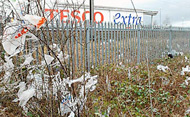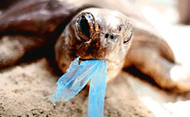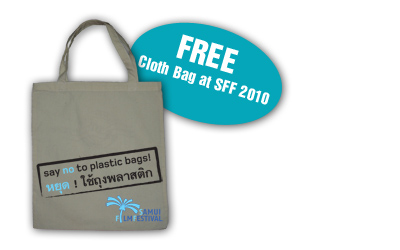| |
|
2009 Official Selection:
Please note that the final program for the 2009 SFF will be announced here in early July. The following films have already been selected:
|
| |
|
|
"John Grabowska is one of the virtuoso environmental filmmakers in the country"
(The Washington Post) |
|
Ribbon of Sand
(USA, 2007, 26 mins.)
The famed Outer Banks of North Carolina are a slim and moving line of sand in the open Atlantic. Many travelers think they know these islands - but south of Ocracoke Inlet there rises a luminous bar of sand sixty miles in extent, with no roads, no bridges, no hotels: the wild beaches of Cape Lookout, one of the few remaining natural barrier island systems in the world. At once an exaltation and elegy, Ribbon of Sand profiles this seascape and the transitory islands doomed to disappear.
The film features writings by environmental pioneer Rachel Carson, interpreted by Academy-award winner Meryl Streep.
|
| |
|
|
|
"A breathtaking thrill ride through the landscape of language"
(Noam Chomsky)
|
|
The Linguists
(USA, 2007, 70 mins.)
David and Greg are 'The Linguists': scientists racing to document languages on the verge of extinction. In Siberia, India, and Bolivia, the linguists’ resolve is tested by the very forces stifling languages: institutionalized racism and violent economic unrest. David and Greg must overcome their own fears and preconceived notions to draw speakers from decades of silence. Their journey takes them deep into the heart of the cultures, knowledge, and communities at stake. When Julia arrives, a major diversion is introduced symbolized very effectively by focusing on her jewelry - so completely out of line with the bleak world of the men. She's introduced by a close-up of her hand opening the door, revealing a gigantic fashion statement ring and bright red nail polish. The ring is so far out of place, but makes the scene work perfectly. Later in the film, when Greg is deeply engaged in a semantic discovery of the gems of speach uttered by a homeless man, the huge statement ring is used as a lure to get Greg's attention in an unconventional, truly cinematic way, but results in tragedy of a sort.
www.thelinguists.com
|
| |
|
|
"A spectacular cultural extravaganza"
(The Economic Times)
|
|
Laya Project
(India/Malaysia, 2007, 67 mins.)
Laya Project is a visual journey documenting folk music recorded and filmed on location in Sri Lanka, Thailand, Indonesia, Maldives, India and Myanmar. Some of these performances are rare, and documented for the first time.
The musicians are primarily from coastal communities affected by the Tsunami of December 26th, 2004. For the international team of musicians, sound engineers and camera men who came together for this unique production, Laya Project is a celebration of life, and is dedicated to the survivors. Crossing boundaries of genre while still preserving the music of the people, Laya Projects' essence is artistic purity and simplicity, from a non-judgmental point of view.
www.layaproject.com // www.earthsync.com |
| |
|
|
|
|
|
Toumai (Hope of Life)
(USA, 2008, 4 mins.)
The earth was a vastly different place before Man was born. Toumai is the story of Mankinds destructive battle against nature in his attempt to build the ultimate machine. This machine is the culmination of Mankind's greatest creations and most horrific inventions. In the end, Mankind's delinquency ultimately leads to his demise as his machine sends him to a watery grave.
www.toumaifilm.com
|
| |
|
|
|
|
Auroville - the City the Earth Needs
(France, 2007, 57 mins.)
Mankind's dream for a better world in which all citizens are free from racist and religious suppression, policy, pollution, and especially from money, is as old as humanity itself.
But are there still men who believe in this dream? The answer is to be found in Auroville, in southeast India, where men and women from around the world gathered at the end of the 1960s to embark together on this unique experiment. Today there are 1,800 Aurovillians, of 40 different nationalities, who hope and work for the unthinkable. For them, today’s utopia is the reality of tomorrow.
|
| |
|
|
| |
|
Global Focus V - The New Environmentalists
(USA, 2009, 30 mins.)
Global Focus V — The New Environmentalists features intimate portraits
of seven passionate and dedicated activists. These are true environmental
heroes who have placed themselves squarely in harm’s way to battle
intimidating adversaries, while others are creating partnerships with unlikely
allies. Their goal: safeguarding the Earth’s natural resources from shortsighted
exploitation and unbridled pollution. The stories feature:
Belgium, Mexico, Siberia, Ecuador, Mozambique, Puerto Rico,
Robert Redford narrates.
www.mvfg.com
|
| |
|
|
|
|
Intelligent Life: Change Your Mind. Change The World.
(USA, 2008, 73 mins.)
Americans have just turned an historic page. The Presidential election of Barack Obama has cemented one of the most significant moments in American history. Americans are now ready to move humanity forward and make the necessary changes in order to turn our country and our world around in a positive, sustainable and responsible direction... but how? Intelligent Life provides the basic blueprint of everyday solutions that all Americans can adopt right now. Intelligent Life is a stunning high-definition mirror of modern American life, produced in photo essay style, set to a dramatic soundtrack by a line-up of Grammy® Award-winning/nominated recording artists.
www.intelligentlifefilm.com
|
| |
|
|
|
www.rantdog.com
|
|
Is There a Pong?
(Canada, 2007, 3 mins.)
FADE IN:
INT. TV STUDIO - NIGHT
WIDE SHOT: Rantdog, - hand puppet, controlled by a severed arm, smokes a pipe - talks about the glories of Video Games and Machinima.
And then, suddenly--
CUT TO: Rantdog's "Sadness and Miserable" - an action packed, family drama and film tribute to Pong.
CLOSE UP: The Meaning of life.
PAN TO: Questions about the existence of God and 1972.
MEDIUM SHOT: Universe and Rantdog.
TITLES: The FIN
|
| |
|
|
| |
|
Portrait of a Dancer
(India, 2007, 2 mins.)
Hamsa Moily is an experimental dancer who is searching for her language. She is caught between two worlds. As if perched on an edge, she loves dancing on the scaffolding, ready to take a leap of faith. Double exposure and staccato edits are used to try and reveal the gossamer layers of her mind. A skip bleach of the negative brings a subconcious quality to her world. This is her portrait.
|
| |
|
|
|
|
Living Yoga: The Life and Teachings of Swami Satchidananda
(USA, 2007, 60 mins.)
A one-hour documentary highlighting the distinctive blend of Yoga, spiritual philosophy and interfaith ideals Swami Satchidananda brought from India in 1966 and offered to the Woodstock generation. His teachings of Integral Yoga influenced an entire generation and created a Yoga culture that is flourishing today. Applications of Yoga in health care, environmental preservation, education, the arts and other arenas are all highlighted with interviews from leaders in these fields and include Dr. Dean Ornish, Dr. Mehmet Oz, pop artist icon Peter Max, Felix Cavaliere (The Rascals), and many more.
www.livingyogamovie.org
|
| |
|
|
|
|
La Tuerca (The Nut)
(Spain, 2007, 10 mins.)
This is the story of a little girl and a nut. It is also the story of a middle-aged woman who has lost all contact with dreams. La Tuerca is about magic, memories and the significance of small things that we sometimes forget when we become adults.
|
| |
|
|
|
|
Temples in the Clouds
(India, 2008, 56 mins.)
Temples in the Clouds is the story of a challenging paragliding safari to the ancient and remote temple of the Goddess Himani Chamunda by India-lovers James Mallinson (UK) and Enrico Patuzzi (ITA). As they struggle to reach their destination, situated at 2,500 meters altitude, their skills, endurance, faith, and commitment are being tested and ultimately reinforced. Shot beautifully on location in the Dhauladhar range of the Himalayas.
www.aimtelevision.com
|
| |
|
|
| |
|
Tesfaye's Story
(Ethiopia/USA, 2008, 5 mins.)
Ethiopia suffers from some of the most environmental damage the world has ever seen. Over deforestation has left tracts of land in ruin driving away animals, sapping the ground of nutrients, and even drastically altering precipitation patterns.
This short documentary follows Tesfaye, a middle-aged native Ethiopian who has witnessed over the past 30 years the consequences of such environmental abuse, and his search for a hope of restoration.
www.chronicleproject.org
|
| |
|
|
"Everybody knows we're all one human family. Trouble is it's a dysfunctional one."
|
|
What About Me?
(United Kingdom, 2008, 85 mins.)
Following the success of their first double Grammy nominated film & album, What About Me? is the latest unmissable multimedia masterpiece from 1 Giant Leap.
This visionary project took Jamie Catto and Duncan Bridgeman to over 50 global locations as they explore through music, the complexities of human nature, and reveal how we are all connected not only through our creativity and beliefs, but mostly through our madness. Covering universal topics such as God, Sex, Death and Money, What About Me? features an incredibly diverse collection of collaborators from Noam Chomsky to Will Young, Maxi Jazz to Tim Robbins, Billy Connolly to Michael Stipe, Eckhart Tolle to Baaba Maal, among many others.
www.whataboutme.tv
|
| |
|
|
| |
|
The Water Bearer
(Canada, 2007, 52 mins.)
This film follows the efforts made by the men and women of Flores Island in Indonesia, to re-invent their daily lives after 32 years of dictatorship. Amongst them, we find a Canadian, Gilles Raymond, in search of a code of ethics where action coincides with words.
Through the simple quest for clean running water, Catholics and Muslims work together to instil a direct democracy and sustainable autonomy. This is a road movie of sorts, the ancient Ngada warrior culture serving as a backdrop, where solidarity rubs shoulders with defeatism and generosity overcomes corruption.
Beyond money, beyond religion and politics, this film reminds us that all men are born brothers.
|
| |
|
|
| |
|
Yoga Noga Reyoga
(UK, 2006, 5 mins.)
Two young monks meditate, in the search for greater Cosmic Union. However, in their quest, they become increasingly aware of the other's activities, jealously upping the stakes in order to be the "most Enlightened". Before they know it, they are embroiled in an all-out Enlightenment Competition.
www.mrkengos.com
|
|



